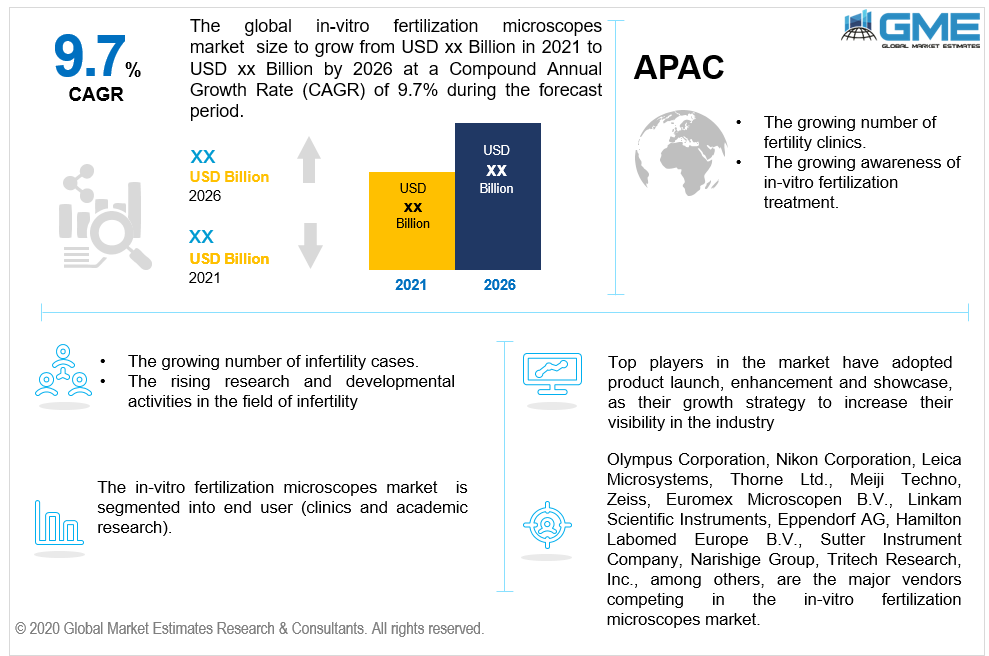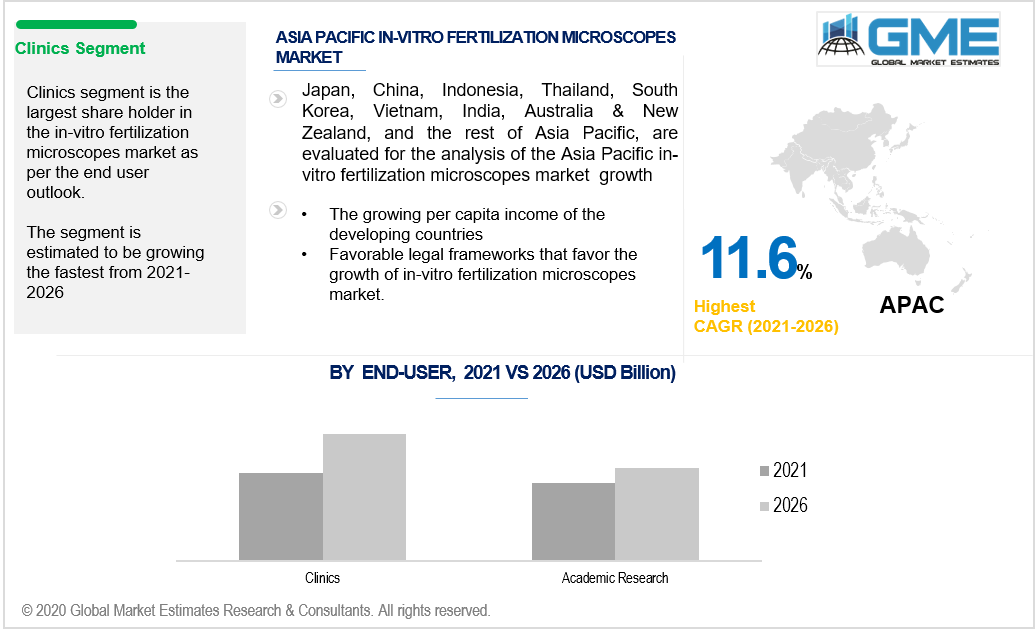
Global In-Vitro Fertilization Microscopes Market Size, Trends, and Analysis - Forecast To 2026 By End User (Clinical, Academic Research), By Region (North America, Asia Pacific, CSA, Europe, and the Middle East and Africa); End-User Landscape, Company Market Share Analysis & Competitor Analysis
In-vitro fertilization microscopes are used in various in-vitro fertilization procedures like oocyte preparation, analyzing the embryo, and semen analysis. The rising demand for in-vitro fertilization to combat male and female infertility combined with the high success rates of in-vitro fertility have been the major drivers of the in-vitro fertilization microscopes market. The rising cases of infertility in males and females have been increasing in recent years, 30% of infertility cases are male infertility cases and account for one-fifth of the total infertility cases worldwide. Growing literacy rates among women and the growing number of working women have seen more women having a family plan in later stages of life due to career commitments. As female fertility is largely driven by age, women are becoming increasingly dependent on fertility treatments to combat infertility and improve conception rates. Several factors like low sperm count and inability to develop eggs have been the major factors to the growing number of infertility cases. In-vitro fertilization treatment has become increasingly popular as it has a high success rate and has further contributed to the growing demand for in-vitro fertilization equipment like in-vitro fertilization microscopes. The rising number of in-vitro fertilization clinics and the growing fertility tourism are also expected to increase the demand for in-vitro fertilization microscopes. In recent years, the number of same-sex marriages has been rising, as these couples cannot conceive naturally, they are increasingly turning to in-vitro fertilization treatments which will, in turn, increase the demand for in-vitro fertilization microscopes. Upright microscopes are largely used in the sample preparation of semen samples. Through detailed semen analysis, male infertility can be studied by analyzing the volume of sperms, the morphology of the sperms, and the number of motile sperms per milliliter. To study male infertility through semen analysis, in-vitro fertilization microscopes are used with differential interference contrast microscopy and polarization. Differential interference contrast microscopes offer high-resolution images that are capable of producing images of the finest structures in the cells. Differential interference microscopy utilizes polarized light to detect the variations in the refraction indices in the light reflected from the samples. Glass dishes or slides have to be used to study samples under a differential interference microscope as plastic is not capable of preserving the polarization of light. Harvested cells from sperms and eggs have to be stored in culture dishes and stored at human body temperatures. This necessitates the need for microscopes with heating stages while examining and selecting the required cells. The initial selection process of cells is carried out through stereo microscopes. As egg cells settle towards the bottom of the dishes, assessment of the cell structure has to be carried out using the lens that is very close to the cells. For this application, inverted microscopes have to be used. Technological advancements and high research and development work carried out by microscope vendors have resulted in new products that increase the in-vitro fertilization treatment efficiency. The development of new products is also expected to have an impact on the price of in-vitro fertilization treatment and reduce the costs associated with in-vitro fertilization treatment. Most development occurs in improving the quality of microscopes through high contrast improvements and are some of the important advancements in the in-vitro fertilization microscopes market. Other innovations occur in the implementation of artificial intelligence, embryo analysis, and sperm selection. In order to study the morphology and cleavage of the embryos, the embryos have to be removed from their cultures to study morphology which increases the stress on the embryos. This limits the number of assessments that can be carried out. By using time-lapse technology that incorporates a microscope with a camera attached enables non-invasive imaging of the embryos at specific intervals of time. Developments have been occurring in implementing artificial intelligence. One such development has been the use of artificial intelligence to assist the sperm selection process which reduces the time required for the intracytoplasmic sperm injection procedure. The in-vitro fertilization microscopes market is restrained by the growing costs associated with the procedure, complications that can arise, and the low awareness of in-vitro fertilization treatment.

Based on the various end-users of in-vitro fertilization microscopes, the in-vitro fertilization microscopes market can be segmented into clinical and academic research segments. The clinical segment is expected to hold the dominant share of the market and is also expected to register the fastest growth rate during the forecast period. Growing awareness of in-vitro fertilization treatments and the growing investment in infertility clinics are the major drivers of this segment. In recent years, the number of fertility clinics has been increasing and is expected to continue to rise which will further increase the demand for in-vitro fertilization microscopes in this segment. In-vitro fertilization clinics offer a wide range of services such as semen analysis, embryo analysis, oocyte identification, freezing and storage of embryos and sperms, and many other services.

Europe is expected to hold the lion’s share of the market during the forecast period. The growing fertility tourism industry in the region is expected to be a major driver of the in-vitro fertilization microscopes market in the region. The increasing R&D activitiesforsmart and latest microscopes to be used for IVF research are expected to increase the demand for in-vitro fertilization microscopes. The region also has favorable legal frameworks that are conducive to the growth of the in-vitro fertilization microscopes market. The APAC region is expected to register the fastest growth rate among all regions during the forecast period. The region has seen an increase in the number of fertility clinics and the numbers are expected to grow which will increase the demand for in-vitro fertilization microscopes in the region. Increasing awareness of in-vitro fertilization treatments, growing per capita income, and the rising number of same-sex couples are also expected to be drivers of the market in the region.
Olympus Corporation, Nikon Corporation, Leica Microsystems, Thorne Ltd., Meiji Techno, Zeiss, Euromex Microscope B.V., Linkam Scientific Instruments, Eppendorf AG, Hamilton Labomed Europe B.V., Sutter Instrument Company, Narishige Group, Tritech Research, Inc., among others, are the major vendors competing in the in-vitro fertilization microscopes market.
Please note: This is not an exhaustive list of companies profiled in the report.
We value your investment and offer free customization with every report to fulfil your exact research needs.
The Global In-Vitro Fertilization Microscopes Market has been studied from the year 2019 till 2026. However, the CAGR provided in the report is from the year 2021 to 2026. The research methodology involved three stages: Desk research, Primary research, and Analysis & Output from the entire research process.

The desk research involved a robust background study which meant referring to paid and unpaid databases to understand the market dynamics; mapping contracts from press releases; identifying the key players in the market, studying their product portfolio, competition level, annual reports/SEC filings & investor presentations; and learning the demand and supply-side analysis for the In-Vitro Fertilization Microscopes Market.

The primary research activity included telephonic conversations with more than 50 tier 1 industry consultants, distributors, and end-use product manufacturers.

Finally, based on the above thorough research process, an in-depth analysis was carried out considering the following aspects: market attractiveness, current & future market trends, market share analysis, SWOT analysis of the company and customer analytics.

Tailor made solutions just for you
80% of our clients seek made-to-order reports. How do you want us to tailor yours?
OUR CLIENTS